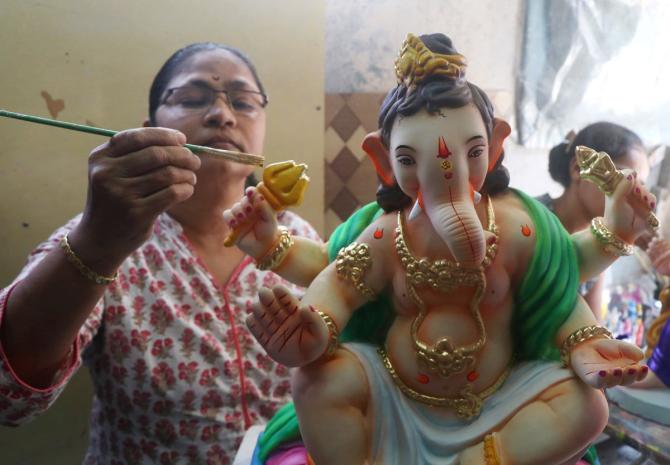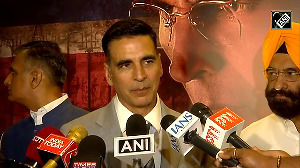'We are called artists, just like the film people and dancers and actors. But there's a very little value to what we do as artists.'

It's been 82 years since the Bagwe family started making marvellously beautiful Ganeshas in the Chichpokli-Lalbaug area of south central Mumbai.
The family patriarch Balkrushna Bagwe began sculpting murtis back in 1941. His stunning craftsmanship was hugely popular and Bagwe became the most sought-after name in the vicinity.
The father was assisted by his three sons, Shashikant, Manohar and Sadanand, and soon the Bagwe family became the creative force in Ganesha-murti creation in the Lalbaug area, where the family first located their business.
Manohar was particularly intrigued by his father's skillset. It inspired the artist in him. Before he started out as a Ganesha murti-maker himself, he would observe his father for hours while he was fully engrossed in his work. It was inevitable that Manohar would follow the profession of his father, who began sculpting at the tender age of 13.
"While many others get money, a house and what not in their inheritance, I got my father's artistic flair," says Manohar, now 68. "Money can be depleted, but art always remains integral to one's existence."

We met Manohar and his family on a particularly busy day on a bright sunny afternoon. As we walked in a narrow lane in Chinchpokli to a small godown, we were greeted by Manohar with a sparkling smile that complements his calm personality. Since their original space in Lalbaug is under renovation, the family has set up a temporary workshop in a private godown on rent.

Each year, three to four months in advance, the master craftsman and his family get busy with preparations for the requirements of the festival. The last two weeks just before Ganesh Utsav are crucial -- that's when the workload mounts as they meet deadlines to tackle sheer volume of their orders, mainly from well-established clientele.
"This year, we are tasked with making about 250 small and medium-sized idols and five big ones for community pandals," explains Manohar. "It is a lot of work and we are also experiencing a shortage of workers, but that's when the entire family come together in full force to make sure we deliver on time. We all love this work passionately."

Manohar, who has won several state awards for his art, specialises in painting beautiful eyes and also 'foldable' Ganeshas that are exported to Australia where Ganesh festivities are organised by the Indian Diaspora. After the sudden passing of his elder brother Shashikant in 2019, Manohar has been running his family enterprise with his younger brother Sadanand and the rest of the family.

When his interlude devoted to Lord Ganesha is over, Manohar sometimes works as an assistant art director on film sets and has lent a helping hand to industry stalwarts like Sabu Cyril and the late Nitin Chandrakant Desai on films like Baahubali, Golmaal, All The Best, Izzat.
"There is so much rush on film sets, which does not always help to an artist like me who likes to work in a calm environment. But the film people value good artists and it always helps to learn something more," he says.

Traditionally, making murtis is considered a man's job. But the women of the Bagwe family have always been integral to the process.
"Women were restricted to errands like serving tea and food to workers, but in our home, we work as a complete team. Each member has a command over some kind of skill and that's how we are able to segregate and divide our work equally amongst us."

His daughter Manaswi is a corporate lawyer with Integreon, who helps him with touch-ups and other aspects of the work. She is currently on her annual 15 days of leave from work to help her family with Ganesha making.
"Since I was a small kid I would play around and do odd little jobs on the unfinished Ganeshas -- it was my ultimate pleasure then which now has turned into a passion," she says.

The clay that is used for idols is usually bought from Bhavnagar in Gujarat, months before the Ganesh festival. But Manohar says the demand for clay murtis has reduced now, because Plaster of Paris Ganeshas have pushed clay versions out of the market.

He expresses his displeasure at how the local Ganesha makers have turned "commercial" to meet the high demands. "Making a single small- to medium-sized idol from scratch takes at least 10 days, and it's a very intrinsic kind of art that requires patience and skills. POP (Plaster of Paris) idols are much easier to create and shape which can save much time and money of the artisans. This attitude has turned them lazy."
The decreasing availability of workers and skilled craftsmen have further made the job even more challenging. "I normally have 25 or 30 craftsmen to manage the workload, but now I have just eight people besides my family to make so many murtis."
Artists like him, he says, have also been struggling to get space to set up their temporary workshops and there is very little hope of getting any form of financial help from the state government.
"The rent is super high and the city authorities offer no help in making it any easier for us. We are called artists, just like the film people and dancers and actors. But there's a very little value to what we do as artists," he says.

Despite the hardships and many challenges, Manohar is determined to carry forward his ancestral artistic heritage.

"I still vividly remember my father's swift hand movements during his work. I used to look at his skillful hands with complete awe," muses Manohar.
"I may or may not have proficiency like him, but I feel his hand on my head and hear his blessing."












 © 2025
© 2025